Essay Writing Guide
Essay Outline
Last updated on: Jun 10, 2023

A Complete Essay Outline - Guidelines and Format
By: Nova A.
13 min read
Reviewed By: Melisa C.
Published on: Jan 15, 2019

To write an effective essay, you need to create a clear and well-organized essay outline. An essay outline will shape the essay’s entire content and determine how successful the essay will be.
In this blog post, we'll be going over the basics of essay outlines and provide a template for you to follow. We will also include a few examples so that you can get an idea about how these outlines look when they are put into practice.
Essay writing is not easy, but it becomes much easier with time, practice, and a detailed essay writing guide. Once you have developed your outline, everything else will come together more smoothly.
The key to success in any area is preparation - take the time now to develop a solid outline and then write your essays!
So, let’s get started!

On this Page
What is an Essay Outline?
An essay outline is your essay plan and a roadmap to essay writing. It is the structure of an essay you are about to write. It includes all the main points you have to discuss in each section along with the thesis statement.
Like every house has a map before it is constructed, the same is the importance of an essay outline. You can write an essay without crafting an outline, but you may miss essential information, and it is more time-consuming.
Once the outline is created, there is no chance of missing any important information. Also, it will help you to:
- Organize your thoughts and ideas.
- Understand the information flow.
- Never miss any crucial information or reference.
- Finish your work faster.
These are the reasons if someone asks you why an essay outline is needed. Now there are some points that must be kept in mind before proceeding to craft an essay outline.

Easily Outline Your Essays In Seconds!
Prewriting Process of Essay Outline
Your teacher may ask you to submit your essay outline before your essay. Therefore, you must know the preliminary guidelines that are necessary before writing an essay outline.
Here are the guidelines:
- You must go through your assignments’ guidelines carefully.
- Understand the purpose of your assignment.
- Know your audience.
- Mark the important point while researching your topic data.
- Select the structure of your essay outline; whether you are going to use a decimal point bullet or a simple one.

Paper Due? Why Suffer? That's our Job!
How to Write an Essay Outline in 4 Steps
Creating an essay outline is a crucial step in crafting a well-structured and organized piece of writing. Follow these four simple steps to create an effective outline:
Step 1: Understand the Topic
To begin, thoroughly grasp the essence of your essay topic.
Break it down into its key components and identify the main ideas you want to convey. This step ensures you have a clear direction and focus for your essay.
Step 2: Brainstorm and Gather Ideas
Let your creativity flow and brainstorm ideas related to your topic.
Jot down key pieces of information, arguments, and supporting evidence that will strengthen your essay's overall message. Consider different perspectives and potential counterarguments to make your essay well-rounded.
Step 3: Organize Your Thoughts
Now it's time to give structure to your ideas.
Arrange your main points in a logical order, starting with an attention-grabbing introduction, followed by body paragraphs that present your arguments.
Finally, tie everything together with a compelling conclusion. Remember to use transitional phrases to create smooth transitions between sections.
Step 4: Add Depth with Subpoints
To add depth and clarity to your essay, incorporate subpoints under each main point.
These subpoints provide more specific details, evidence, or examples that support your main ideas. They help to further strengthen your arguments and make your essay more convincing.
By following these four steps - you'll be well on your way to creating a clear and compelling essay outline.
Essay Outline Format
It is an easy way for you to write your thoughts in an organized manner. It may seem unnecessary and unimportant, but it is not.
It is one of the most crucial steps for essay writing as it shapes your entire essay and aids the writing process.
An essay outline consists of three main parts:
1. Introduction
The introduction body of your essay should be attention-grabbing. It should be written in such a manner that it attracts the reader’s interest. It should also provide background information about the topic for the readers.
You can use a dramatic tone to grab readers’ attention, but it should connect the audience to your thesis statement.
Here are some points without which your introduction paragraph is incomplete.
To attract the reader with the first few opening lines, we use a hook statement. It helps engage the reader and motivates them to read further. There are different types of hook sentences ranging from quotes, rhetorical questions to anecdotes and statistics, and much more.
Are you struggling to come up with an interesting hook? View these hook examples to get inspired!
A thesis statement is stated at the end of your introduction. It is the most important statement of your entire essay. It summarizes the purpose of the essay in one sentence.
The thesis statement tells the readers about the main theme of the essay, and it must be strong and clear. It holds the entire crux of your essay.
Need help creating a strong thesis statement? Check out this guide on thesis statements and learn to write a statement that perfectly captures your main argument!
2. Body Paragraphs
The body paragraphs of an essay are where all the details and evidence come into play. This is where you dive deep into the argument, providing explanations and supporting your ideas with solid evidence.
If you're writing a persuasive essay, these paragraphs will be the powerhouse that convinces your readers. Similarly, in an argumentative essay, your body paragraphs will work their magic to sway your audience to your side.
Each paragraph should have a topic sentence and no more than one idea. A topic sentence is the crux of the contents of your paragraph. It is essential to keep your reader interested in the essay.
The topic sentence is followed by the supporting points and opinions, which are then justified with strong evidence.
3. Conclusion
When it comes to wrapping up your essay, never underestimate the power of a strong conclusion. Just like the introduction and body paragraphs, the conclusion plays a vital role in providing a sense of closure to your topic.
To craft an impactful conclusion, it's crucial to summarize the key points discussed in the introduction and body paragraphs. You want to remind your readers of the important information you shared earlier. But keep it concise and to the point. Short, powerful sentences will leave a lasting impression.
Remember, your conclusion shouldn't drag on. Instead, restate your thesis statement and the supporting points you mentioned earlier. And here's a pro tip: go the extra mile and suggest a course of action. It leaves your readers with something to ponder or reflect on.
5 Paragraph Essay Outline Structure
An outline is an essential part of the writing as it helps the writer stay focused. A typical 5 paragraph essay outline example is shown here. This includes:
- State the topic
- Thesis statement
- Introduction
- Explanation
- A conclusion that ties to the thesis
- Summary of the essay
- Restate the thesis statement
Tough Essay Due? Hire Tough Writers!
Essay Outline Template
The outline of the essay is the skeleton that you will fill out with the content. Both outline and relevant content are important for a good essay. The content you will add to flesh out the outline should be credible, relevant, and interesting.
The outline structure for the essay is not complex or difficult. No matter which type of essay you write, you either use an alphanumeric structure or a decimal structure for the outline.
Below is an outline sample that you can easily follow for your essay.
Essay Outline Sample
Essay Outline Examples
An essay outline template should follow when you start writing the essay. Every writer should learn how to write an outline for every type of essay and research paper.
Essay outline 4th grade
Essay outline 5th grade
Essay outline high school
Essay outline college
Given below are essay outline examples for different types of essay writing.
Argumentative Essay Outline
An argumentative essay is a type of essay that shows both sides of the topic that you are exploring. The argument that presents the basis of the essay should be created by providing evidence and supporting details.
Persuasive Essay Outline
A persuasive essay is similar to an argumentative essay. Your job is to provide facts and details to create the argument. In a persuasive essay, you convince your readers of your point of view.
Compare and Contrast Essay Outline
A compare and contrast essay explains the similarities and differences between two things. While comparing, you should focus on the differences between two seemingly similar objects. While contrasting, you should focus on the similarities between two different objects.
Narrative Essay Outline
A narrative essay is written to share a story. Normally, a narrative essay is written from a personal point of view in an essay. The basic purpose of the narrative essay is to describe something creatively.
Expository Essay Outline
An expository essay is a type of essay that explains, analyzes, and illustrates something for the readers. An expository essay should be unbiased and entirely based on facts. Be sure to use academic resources for your research and cite your sources.
Analytical Essay Outline
An analytical essay is written to analyze the topic from a critical point of view. An analytical essay breaks down the content into different parts and explains the topic bit by bit.
Rhetorical Analysis Essay Outline
A rhetorical essay is written to examine the writer or artist’s work and develop a great essay. It also includes the discussion.
Cause and Effect Essay Outline
A cause and effect essay describes why something happens and examines the consequences of an occurrence or phenomenon. It is also a type of expository essay.
Informative Essay Outline
An informative essay is written to inform the audience about different objects, concepts, people, issues, etc.
The main purpose is to respond to the question with a detailed explanation and inform the target audience about the topic.
Synthesis Essay Outline
A synthesis essay requires the writer to describe a certain unique viewpoint about the issue or topic. Create a claim about the topic and use different sources and information to prove it.
Literary Analysis Essay Outline
A literary analysis essay is written to analyze and examine a novel, book, play, or any other piece of literature. The writer analyzes the different devices such as the ideas, characters, plot, theme, tone, etc., to deliver his message.
Definition Essay Outline
A definition essay requires students to pick a particular concept, term, or idea and define it in their own words and according to their understanding.
Descriptive Essay Outline
A descriptive essay is a type of essay written to describe a person, place, object, or event. The writer must describe the topic so that the reader can visualize it using their five senses.
Evaluation Essay Outline
Problem Solution Essay Outline
In a problem-solution essay, you are given a problem as a topic and you have to suggest multiple solutions on it.
Scholarship Essay Outline
A scholarship essay is required at the time of admission when you are applying for a scholarship. Scholarship essays must be written in a way that should stand alone to help you get a scholarship.
Reflective Essay Outline
A reflective essay is written to express your own thoughts and point of view regarding a specific topic.
Getting started on your essay? Give this comprehensive essay writing guide a read to make sure you write an effective essay!
With this complete guide, now you understand how to create an outline for your essay successfully. However, if you still can’t write an effective essay, then the best option is to consult a professional academic writing service.
Essay writing is a dull and boring task for some people. So why not get some help instead of wasting your time and effort? 5StarEssays.com is here to help you. All your do my essay for me requests are managed by professional essay writers.
Place your order now, and our team of expert academic writers will help you.
Frequently Asked Questions
What are the three types of outlines.
Here are the three types of essay outline;
- Working outline
- Speaking outline
- Full-sentence outline
All three types are different from each other and are used for different purposes.
What does a full-sentence outline look like?
A full sentence outline contains full sentences at each level of the essay’s outline. It is similar to an alphanumeric outline and it is a commonly used essay outline.
What is a traditional outline format?
A traditional essay outline begins with writing down all the important points in one place and listing them down and adding sub-topics to them. Besides, it will also include evidence and proof that you will use to back your arguments.
What is the benefit of using a traditional outline format and an informal outline format?
A traditional outline format helps the students in listing down all the important details in one palace while an informal outline will help you coming up with new ideas and highlighting important points

As a Digital Content Strategist, Nova Allison has eight years of experience in writing both technical and scientific content. With a focus on developing online content plans that engage audiences, Nova strives to write pieces that are not only informative but captivating as well.
Was This Blog Helpful?
Keep reading.
- How to Write an Essay - A Complete Guide with Examples

- The Art of Effective Writing: Thesis Statements Examples and Tips

- Writing a 500 Word Essay - Easy Guide

- What is a Topic Sentence - An Easy Guide with Writing Steps & Examples

- 220 Best Transition Words for Essays

- Essay Format: Detailed Writing Tips & Examples

- How to Write a Conclusion - Examples & Tips

- Essay Topics: 100+ Best Essay Topics for your Guidance

- How to Title an Essay: A Step-by-Step Guide for Effective Titles

- How to Write a Perfect 1000 Word Essay

- How To Make An Essay Longer - Easy Guide For Beginners

- Learn How to Start an Essay Effectively with Easy Guidelines

- Types of Sentences With Examples

- Hook Examples: How to Start Your Essay Effectively

- Essay Writing Tips - Essential Do’s and Don’ts to Craft Better Essays

- How To Write A Thesis Statement - A Step by Step Guide

- Art Topics - 200+ Brilliant Ideas to Begin With

- Writing Conventions and Tips for College Students

People Also Read
- writing a conclusion for an argumentative essay
- quantitative research
- how to write an abstract
- cause and effect essay topics
- list of social issues
Burdened With Assignments?

Advertisement
- Homework Services: Essay Topics Generator
© 2024 - All rights reserved
Trying to devise a structure for your essay can be one of the most difficult parts of the writing process. Making a detailed outline before you begin writing is a good way to make sure your ideas come across in a clear and logical order. A good outline will also save you time in the revision process, reducing the possibility that your ideas will need to be rearranged once you've written them.
The First Steps
Before you can begin outlining, you need to have a sense of what you will argue in the essay. From your analysis and close readings of primary and/or secondary sources you should have notes, ideas, and possible quotes to cite as evidence. Let's say you are writing about the 1999 Republican Primary and you want to prove that each candidate's financial resources were the most important element in the race. At this point, your notes probably lack much coherent order. Most likely, your ideas are still in the order in which they occurred to you; your notes and possible quotes probably still adhere to the chronology of the sources you've examined. Your goal is to rearrange your ideas, notes, and quotes—the raw material of your essay—into an order that best supports your argument, not the arguments you've read in other people's works. To do this, you have to group your notes into categories and then arrange these categories in a logical order.
Generalizing
The first step is to look over each individual piece of information that you've written and assign it to a general category. Ask yourself, "If I were to file this in a database, what would I file it under?" If, using the example of the Republican Primary, you wrote down an observation about John McCain's views on health care, you might list it under the general category of "Health care policy." As you go through your notes, try to reuse categories whenever possible. Your goal is to reduce your notes to no more than a page of category listings.
Now examine your category headings. Do any seem repetitive? Do any go together? "McCain's expenditure on ads" and "Bush's expenditure on ads," while not exactly repetitive, could easily combine into a more general category like "Candidates' expenditures on ads." Also, keep an eye out for categories that no longer seem to relate to your argument. Individual pieces of information that at first seemed important can begin to appear irrelevant when grouped into a general category.
Now it's time to generalize again. Examine all your categories and look for common themes. Go through each category and ask yourself, "If I were to place this piece of information in a file cabinet, what would I label that cabinet?" Again, try to reuse labels as often as possible: "Health Care," "Foreign Policy," and "Immigration" can all be contained under "Policy Initiatives." Make these larger categories as general as possible so that there are no more than three or four for a 7-10 page paper.
With your notes grouped into generalized categories, the process of ordering them should be easier. To begin, look at your most general categories. With your thesis in mind, try to find a way that the labels might be arranged in a sentence or two that supports your argument. Let's say your thesis is that financial resources played the most important role in the 1999 Republican Primary. Your four most general categories are "Policy Initiatives," "Financial Resources," "Voters' Concerns," and "Voters' Loyalty." You might come up with the following sentence: ÒAlthough McCain's policy initiatives were closest to the voters' concerns, Bush's financial resources won the voters' loyalty.Ó This sentence should reveal the order of your most general categories. You will begin with an examination of McCain's and Bush's views on important issues and compare them to the voters' top concerns. Then you'll look at both candidates' financial resources and show how Bush could win voters' loyalty through effective use of his resources, despite his less popular policy ideas.
With your most general categories in order, you now must order the smaller categories. To do so, arrange each smaller category into a sentence or two that will support the more general sentence you've just devised. Under the category of "Financial Resources," for instance, you might have the smaller categories of "Ad Expenditure," "Campaign Contributions" and "Fundraising." A sentence that supports your general argument might read: "Bush's early emphasis on fundraising led to greater campaign contributions, allowing him to have a greater ad expenditure than McCain."
The final step of the outlining process is to repeat this procedure on the smallest level, with the original notes that you took for your essay. To order what probably was an unwieldy and disorganized set of information at the beginning of this process, you need now only think of a sentence or two to support your general argument. Under the category "Fundraising," for example, you might have quotes about each candidate's estimation of its importance, statistics about the amount of time each candidate spent fundraising, and an idea about how the importance of fundraising never can be overestimated. Sentences to support your general argument might read: "No candidate has ever raised too much money [your idea]. While both McCain and Bush acknowledged the importance of fundraising [your quotes], the numbers clearly point to Bush as the superior fundraiser [your statistics]." The arrangement of your ideas, quotes, and statistics now should come naturally.
Putting It All Together
With these sentences, you have essentially constructed an outline for your essay. The most general ideas, which you organized in your first sentence, constitute the essay's sections. They follow the order in which you placed them in your sentence. The order of the smaller categories within each larger category (determined by your secondary sentences) indicates the order of the paragraphs within each section. Finally, your last set of sentences about your specific notes should show the order of the sentences within each paragraph. An outline for the essay about the 1999 Republican Primary (showing only the sections worked out here) would look something like this:
I. POLICY INITIATIVES
II. VOTERS' CONCERNS
III. FINANCIAL RESOURCES
A. Fundraising
a. Original Idea
b. McCain Quote/Bush Quote
c. McCain Statistics/Bush Statistics
B. Campaign Contributions
C. Ad Expenditure
IV. VOTERS' LOYALTY
Copyright 2000, David Kornhaber, for the Writing Center at Harvard University
Home / Guides / Writing Guides / Parts of a Paper / How to Write an Essay Outline
How to Write an Essay Outline
It’s 11 p.m., your paper is due tomorrow, and you’re only about halfway done. You’re typing along and when you realize that, wait…you’re actually not a huge fan of your argument or the supporting examples you’re using. Your options are to haphazardly keep writing or to backtrack and rehash what you’ve already done. Ugh. Unsurprisingly, both options aren’t great.
This scenario is scary, but totally avoidable! Though it’s tempting to just start writing, one of the best steps you can take before you type a single word is to create an outline for your paper. By taking the time to write a paper outline, you can prevent the scenario above and make your writing process a cinch!
Guide Overview
What is a paper outline, why it’s worth writing an outline.
- Step 1: gather your relevant materials
- Step 2: create your thesis
- Step 3: find examples
- Step 4: analyze your examples
- Step 5: arrange your examples
A paper outline is a skeletal version of your paper. Another way to think about an outline is to view it as a roadmap. An outline helps you organize and streamline your thoughts ahead of time. By front loading this work, you allow the eventual writing process to be much easier: instead of having to backtrack and see if your paper makes sense, you can refer to your outline and be rest assured that you’re on the right track.
It’s understandable if you think it’s not worth the time to write an outline. After all, writing a paper in itself is a lot of work – why add an extra step?
Here’s the secret: creating an outline and then writing your paper takes about the same amount of time as jumping straight into writing your paper. Why? By immediately writing, you run the risk of having to go back and see if the flow of your paper makes sense. Backtracking takes up a lot of time: having to go back and revise your paper because you missed a point can be a pain.
Taking the time to outline your paper gives you the space to see what arguments work, which examples to include, and more. Doing this prep work ahead of time prevents you from having to do it while in the middle of your paper. Your completed outline serves as a solid reference as you write your assignment. In an ideal world, your outline should be so thorough that the writing process is essentially just you converting your bullet points into sentences that flow together!
How to outline a paper
Step 1: gather your relevant materials.
The first step to take when outlining a paper is to gather all your relevant materials. If you’re writing a paper about a book you’re reading in class, start thinking about which passages from the book are relevant to your prompt. If you’re writing a paper about a broader topic, identify what sources you’ll need to construct your argument.
Pro tip: Avoid plagiarism and keep track of the sources you’re using at EasyBib.com! Easily create an APA or MLA format citation , try out our Chicago citation generator , and find help for other citation styles.
Step 2: Create your thesis
After you’ve compiled your materials, start thinking about your thesis statement. Revisit your assignment prompt, peruse your materials, and determine what your viewpoint is regarding the prompt.
Step 3: Find examples
Once you have your thesis, come up with ways to support it. Identify the quotes you need or the arguments you want to utilize in order to bolster your thesis.
Step 4: Analyze Your Examples
Write 3-4 bullet points connecting your examples to your thesis. The analysis part of your paper is the meat of your paper, so feel free to take as much time as you want during this step.
Step 5: Arrange Your Examples
Now that you have your examples and analysis, arrange them in a logical way that helps you develop and support your thesis. This is the step in which you can start copying and pasting your notes into an outline that mimics the flow of your paper. By the end of this step, you should have a solid outline!
Here’s a template for a five paragraph essay you can use for your papers moving forward:

Before you jump into writing your paper, it might pay to take a quick look at our EasyBib grammar guides . Discover what an abstract noun is, read a determiner definition , see the difference between regular and irregular verbs , and get familiar with other parts of speech.
EasyBib Writing Resources
Writing a paper.
- Academic Essay
- Argumentative Essay
- College Admissions Essay
- Expository Essay
- Persuasive Essay
- Research Paper
- Thesis Statement
- Writing a Conclusion
- Writing an Introduction
- Writing an Outline
- Writing a Summary
EasyBib Plus Features
- Citation Generator
- Essay Checker
- Expert Check Proofreader
- Grammar Checker
- Paraphrasing Tools
Plagiarism Checker
- Spell Checker
How useful was this post?
Click on a star to rate it!
We are sorry that this post was not useful for you!
Let us improve this post!
Tell us how we can improve this post?
Grammar and Plagiarism Checkers
Grammar Basics
Plagiarism Basics
Writing Basics
Upload a paper to check for plagiarism against billions of sources and get advanced writing suggestions for clarity and style.
Get Started
How to Write an Essay Outline in 4 Steps | Examples
Learn how to write an essay outline with our expert guide. We also shared some essay outline examples for you to clear understanding. Start writing essays like a pro today!

Rijvi Ahmed
Last updated on Mar 14th, 2024

When you click on affiliate links on QuillMuse.com and make a purchase, you won’t pay a penny more, but we’ll get a small commission—this helps us keep up with publishing valuable content on QuillMuse. Read More .
Table of Contents
Have you ever stared at a blank page, an essay prompt looming, feeling completely lost? You’re not alone. Many students struggle to translate their thoughts into a well-structured and compelling essay. The key to conquering this challenge often lies in a fundamental step: writing a strong essay outline. But you don’t know how to write an essay outline.
This might seem like an extra load, but trust me, it’s an investment that will pay off big time. Consider an outline to be your essay’s template. It offers a clear road map that directs your ideas and arguments systematically and sensibly.
Today, we’ll break down the process of writing an effective essay outline, turning essay writing from a daunting task to a streamlined success story.
Why an Essay Outline is Your Secret Weapon
Writing an essay [1] can feel overwhelming, like staring up a giant mountain. You have a goal in mind or your thesis statement, which is like reaching the peak, but figuring out how to get there feels like a confusing journey. That’s where an essay outline comes in to help you. It’s like a map that helps you:
- Organize your thoughts : Just like packing for a trip, you need to gather your ideas. An outline lets you brainstorm and see how everything connects before you start writing.
- Build a strong argument : A good outline helps you focus on your main points and the evidence that supports them. It’s like planning your route. you know exactly which points you need to hit to reach your destination or thesis.
- Write efficiently : With a clear roadmap, you won’t waste time getting lost. You’ll know exactly what goes in each paragraph, making writing faster and smoother.
- Avoid writer’s block : A blank page can be scary! An outline gives you a starting point and keeps you on track, preventing that dreaded feeling of being stuck.
An outline is basically your personal writing coach, strategist, and cheerleader all in one. It helps you get your thoughts organized, build a strong argument, write faster, and avoid getting stuck. So, next time you have an essay due, forget the fear and grab your outline writing tools . You’ll be surprised at how much easier and more successful writing becomes.
In short, an essay outline is your secret weapon for conquering essay writing. It helps you organize your thoughts, build a strong argument, write efficiently, and avoid writer’s block.
What is a Perfect Essay Outline

You might think an essay outline needs to be super fancy, but that’s not true! The best outlines are clear and organized, and help you build a strong essay. Here’s what goes into this winning formula:
- Clear and Concise : Your outline is like a map, not a story. Use short words or key ideas to show what each part is about. Keep it short and sweet – you can add details later in your essay.
- Logical Flow : Imagine explaining your essay to a friend. Your outline should be like a guide for that conversation. Each part should connect easily to the next, leading your friend (and later, your reader) on a clear and interesting path from the beginning to the end of your essay.
- Thesis Powerhouse : Your thesis statement is the heart of your essay, and your outline should reflect its importance. Make sure your outline clearly highlights your thesis and how each body paragraph supports it.
- Evidence Essentials : Don’t just write down what you’ll talk about in each paragraph. A great outline also mentions the stuff you’ll use to prove your points, like facts, numbers, quotes, or even stories. Having this info handy keeps you on track and helps you write faster.
- Balanced Structure : Think of your essay like a team. Each paragraph is a player, and they all need to work together. Your outline helps make sure each paragraph has its own clear job that supports your main idea.
By following these simple ingredients, you can write an essay outline that serves as a powerful tool for writing success. It will keep your thoughts organized, your arguments focused, and your essay on track for an impressive finish!
The Main Parts of an Essay
Imagine your essay is like a three-act play, with each part working together to tell a clear and interesting story. Here’s a look at the main sections of an essay and what they do:
1. The Introduction
The introduction is like the beginning of a play. It introduces the topic and grabs the reader’s attention. You might start with a question, a surprising fact, or an interesting story to make them want to read more.
Then, you’ll give some background information to help the reader understand what you’re talking about. Finally, you’ll state your thesis statement , which is like the main idea of the play. This is a short sentence that tells the reader exactly what you’ll be arguing throughout your essay.
2. The Body Paragraphs
Think of your essay’s body paragraphs like chapters in a story. Each chapter focuses on one main idea that helps prove your main point or thesis. Imagine you’re trying to convince a friend of something – each chapter would be a reason why they should believe you.
To make your chapters convincing, you need evidence. This is like showing your friend proof! The evidence can be anything from facts and numbers to quotes from experts, or even your own experiences that show your point is true.
Transitions between chapters, like in a story, help things flow smoothly. They connect one idea to the next, making your argument clear and easy to follow. This way, each chapter builds on the one before it, making your overall argument even stronger.
3. The Conclusion
Wrap things up with a strong conclusion, like the final act of a play that leaves the audience thinking. Briefly remind the reader of the key points you made, but avoid just repeating yourself.
Instead, explain why your argument matters and what it means in the bigger picture. End with a thought-provoking idea that ties back to your thesis statement , leaving the reader with something to consider and creating a satisfying finish to your essay.
How to Write an Essay Outline: A 4-Step Guide
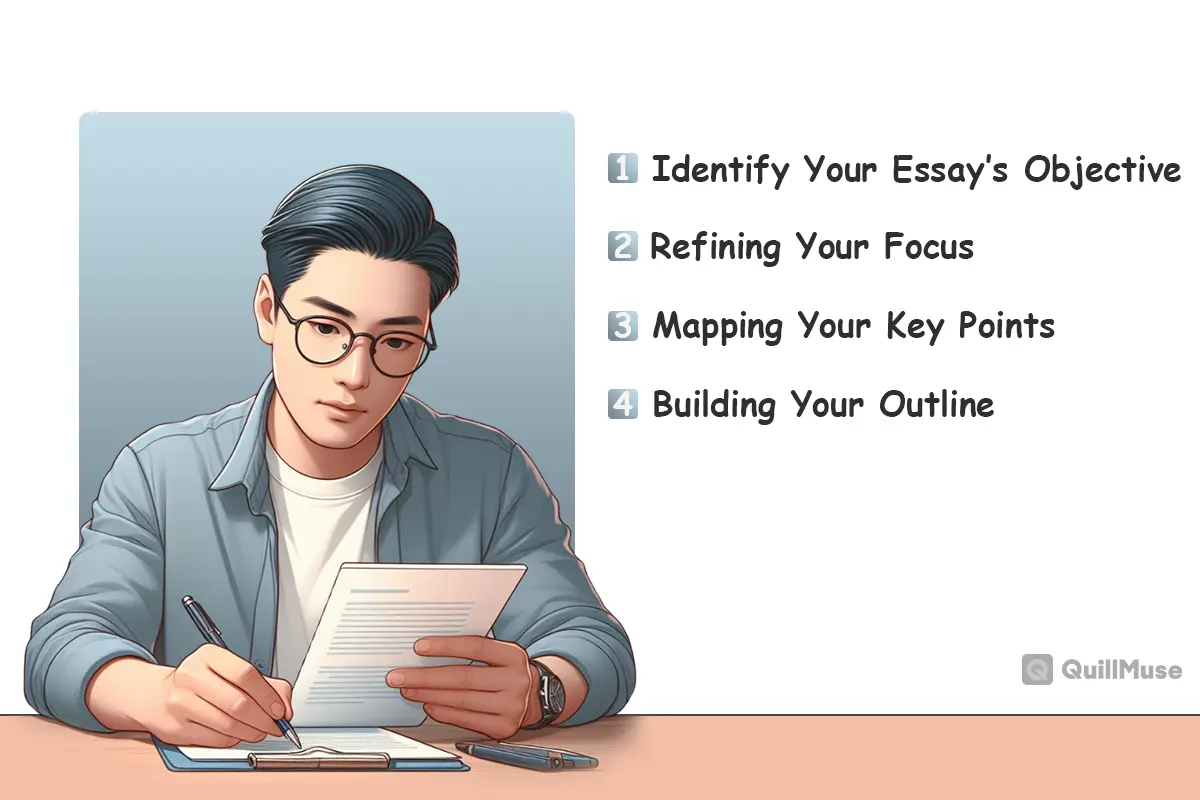
Writing a great essay can be tough, but there’s a secret weapon that can make things much easier: the essay outline.
Think of an outline like a map for your essay. It helps you organize your ideas and build a strong argument, just like a blueprint helps an architect build a house. Ready to ditch writer’s block and write your essay with confidence? Let’s break down the steps to creating an awesome outline.
Step 1: Identify Your Essay’s Objective
Every essay has a specific goal, like a top-secret mission! Before you dive into crafting your outline, take a moment to crack the code and understand the type of essay you’re tackling.
Are you a persuasive detective, building a case to convince the reader of your viewpoint, or argumentative essay? Or are you an undercover storyteller, crafting a captivating narrative that unfolds like a thrilling adventure?
It helps you tailor your outline for maximum impact, ensuring you choose the best approach for presenting your ideas and achieving your essay’s goal.
Step 2: Refining Your Focus
Brainstorming is like a fun playground where you can explore all sorts of ideas for your essay. But now it’s time to get serious and focus on your essay’s main goal.
Think of all your brainstorming notes as a giant pile of toys. Now you need to be like Mission Control, picking the toys that will help you launch your essay into outer space (success!).
After considering each concept, ask yourself, “Does this support my main argument?” If you can’t give a clear answer about how the idea supports your main argument, it’s okay to set it aside.
Just keep the important stuff – the ideas that are like powerful rockets, ready to take your essay to the top. Getting rid of the “fluff” helps you focus on the best ideas and build a strong, clear outline.
Step 3: Mapping Your Key Points
Now that you have your mission-critical points, let’s turn them into a winning strategy for your essay. Look at those strong arguments you identified the ones that really back up your main idea.
These will become the main parts of your essay, like chapters in a book, or paragraphs that focus on one key point. Think of it like this: Imagine you’re writing an essay about why your school needs more water fountains.
Your key arguments, the points you want to make, might be:
- Water fountains save students money.
- Fountains help reduce plastic waste.
- Having more water fountains can prevent heat exhaustion.
All these important details you gathered, along with your main points, are like the building blocks of your essay outline. Having a clear outline is like having a roadmap for writing a strong essay. It shows you exactly where to put all your information to create a well-supported and convincing piece of writing.
Step 4: Building Your Outline
Now you’ve figured out your essay goal, sorted through your ideas, and identified your key points. Time to build the actual outline like constructing the skeleton of your essay.
There are different outline styles depending on the essay type. For now, let’s focus on a basic template that works for most essays with an introduction, body paragraphs, and conclusion.
Here’s how to get started:
- Grab Your Template : There are many outline templates available online or in writing guides. Choose one that’s clear and easy to understand.
- Fill in the Blanks : Using the key points and supporting details you identified earlier, start filling out the sections of your outline template.
- Introduction : Briefly mention your topic and hook the reader. Then, state your thesis statement clearly.
- Body Paragraphs : Each paragraph should represent a single key point that supports your thesis. List these points in your outline, along with some brief notes about the evidence you’ll use to back them up.
- Conclusion : Briefly summarize your main points and leave a lasting impression.
Remember, keep your outline clear and concise. Use bullet points, short phrases, or keywords to capture the essence of each section. Don’t get bogged down by writing elaborate sentences at this stage.
By following these steps, you’ll be well on your way to crafting a strong outline that serves as a roadmap to writing success.
Essay Outline Examples
Feeling stumped for an essay topic? No worries! This example shows you how to craft a strong outline for a descriptive essay, focusing on a relatable experience:
Argumentative Essay Outline
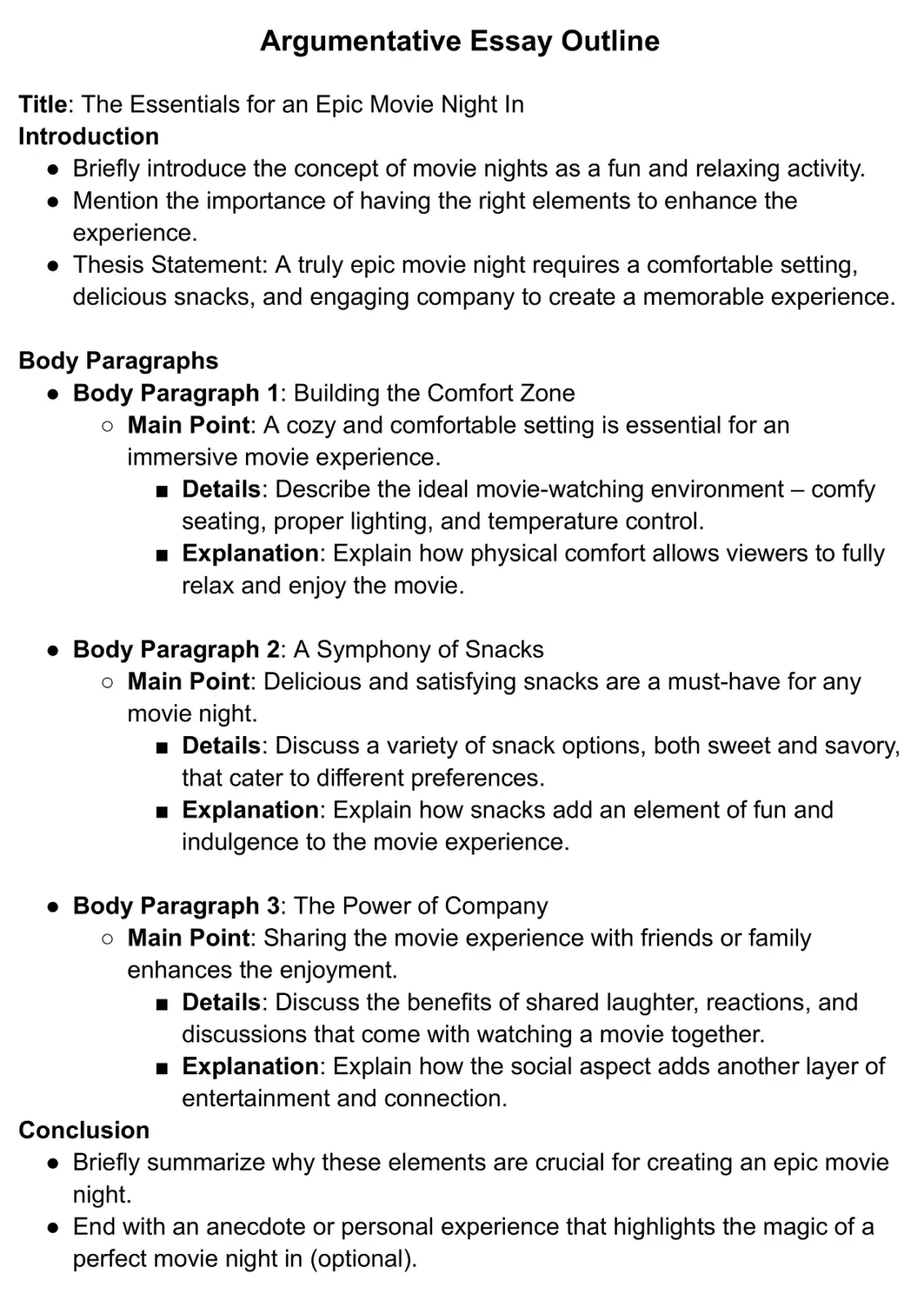
Remember, this is just a sample personalize and expand upon this outline to capture the unique elements that make your movie nights truly unforgettable.
Persuasive Essay Outline
Title : Ditch the Car, Ride the Bus: Why Public Transportation Should Be Your Go-To
Introduction
- Briefly introduce the current reliance on personal vehicles for everyday travel.
- Mention the growing concerns about traffic congestion and environmental pollution.
- Thesis Statement: Public transportation offers a more efficient, environmentally friendly, and cost-effective alternative to personal car usage, and its widespread adoption should be encouraged.
Body Paragraphs
Body Paragraph 1 : Battling Gridlock
- Main Point : Public transportation significantly reduces traffic congestion on our roads.
- Evidence : Cite statistics on the number of vehicles removed from the road with increased public transport usage.
- Explanation : Explain how fewer cars translate to smoother traffic flow, shorter commute times, and a less stressful driving experience for everyone.
Body Paragraph 2 : Saving the Planet, One Ride at a Time
- Main Point : Public transportation plays a crucial role in reducing greenhouse gas emissions and combating climate change.
- Evidence : Cite statistics on the lower carbon footprint of public transport compared to personal vehicles.
- Explanation : Discuss the positive impact of reducing reliance on fossil fuels and creating a cleaner environment for all.
Body Paragraph 3 : Saving Money on the Move
- Main Point : Public transportation offers a more budget-friendly option compared to owning and maintaining a car.
- Evidence : Compare the costs of public transportation passes or tickets with the expenses of gas, car maintenance, and insurance.
- Explanation : Highlight how opting for public transport can free up money for other expenses or allow individuals to save for the future.
- Briefly summarize the benefits of public transportation – reduced traffic, environmental protection, and cost savings.
- Emphasize the importance of a shift towards a more sustainable and economical transportation system.
- End with a call to action, encouraging readers to consider using public transportation more frequently (optional).
This example shows you how to take the persuasive essay structure and use it for a new topic. Remember, you can add your own details about public transportation in your area and change them to fit the people you’re writing to!
Admissions Essay Outline
Title : From Shy Singer to Stage Presence: A Band Odyssey
- Briefly introduce your initial discomfort with singing and performing in front of others.
- Mention how joining your school band changed your perspective on music and self-expression.
- Thesis Statement: Participating in my high school band transformed me from a shy singer into a confident performer, fostering a deeper appreciation for music and collaboration.
- Details : Describe your feelings of anxiety and how performing felt like a daunting challenge.
- Explanation : Explain how this initial discomfort almost made you quit the band altogether.
- Details : Mention specific examples of how your band director or peers helped you feel more comfortable expressing yourself.
- Explanation : Explain how the positive and encouraging atmosphere within the band fostered your confidence and passion for music.
- Details : Describe the process of working together with other musicians to achieve a unified sound.
- Explanation : Explain how learning to play your part effectively within the band fostered a sense of teamwork and a deeper appreciation for different musical roles.
- Briefly summarize the transformative impact of band participation on your confidence, self-expression, and teamwork skills.
- Emphasize how these skills developed through music will benefit you in your future endeavors.
Personal Essay Outline
- Briefly introduce the special bond you share with your dog.
- Mention a specific incident where your dog’s actions surprised and impressed you.
- Thesis Statement: During a seemingly ordinary walk in the park, my dog, [Dog’s Name], showcased his bravery and became my hero most unexpectedly.
Body Paragraph
- Describe the setting in detail – what park were you in? What was the weather like?
- Explain what happened – what were you doing with your dog when the incident occurred?
- Focus on the details of your dog’s actions – how did they react to the situation? What did they do that surprised you?
- Explain the impact of your dog’s actions – did they protect you from danger? Did they alert you to something you missed?
- Describe your emotions after the incident – were you relieved? Grateful? Proud of your dog?
- You can mention specific details or reactions from others that highlight your dog’s heroism.
- Briefly summarize your dog’s heroic act and its significance.
- Reflect on the deepened bond you share with your dog due to this experience.
- You can end with a heartwarming anecdote about your dog’s continued presence as your furry hero (optional).
FAQs: How to Write an Essay Outline
These FAQs will provide some helpful information to readers seeking guidance on how to write an essay outline.
When should I write an essay outline?
There’s no one-size-fits-all answer. Some writers prefer outlining before diving into the first draft, while others use it as they go. Try different things to see what suits you the best.
Isn’t outlining just a waste of time?
On the contrary, an outline saves time in the long run. By organizing your thoughts beforehand, you avoid getting sidetracked and rewriting entire sections later.
What are some common essay outline formats?
There are various formats, but a popular one uses Roman numerals (I, II, III) for main points, capital letters (A, B, C) for sub-points, and Arabic numerals (1, 2, 3) for further details. Bullet points and short phrases are also common for keeping things concise.
Are there any online tools that can help me outline?
Yes! There are several online outlining tools and templates available. They can provide a visual structure and guide you through the outlining process.
Do teachers always require essay outlines?
Not always, but they can be a valuable addition, especially for longer or complex essays. If unsure, always check with your teacher for specific requirements.
How long should my essay outline be?
There’s no set length. It should be detailed enough to guide your writing but not so detailed it becomes a full draft. Aim for clarity and functionality.
How we've reviewed this article
Our content is thoroughly researched and fact-checked using reputable sources. While we aim for precision, we encourage independent verification for complete confidence.
1. https://en.wikipedia.org/wiki/Essay
We keep our articles up-to-date regularly to ensure accuracy and relevance as new information becomes available.
- Current Version
- Mar 14th, 2024
- Mar 13th, 2024
Share this article
Leave a Comment Login Please login to comment 0 Comments Inline Feedbacks View all comments
Prev Previous Next Next
Have you ever stared at a blank page, an essay prompt looming, feeling completely lost? You’re not alone. Many students struggle to translate their thoughts into a well-structured and compelling essay. The key to conquering this challenge often lies in a fundamental step: writing a strong essay outline. But you

How to Write a Book Title in an Essay in MLA & APA Styles
In academic writing, attention to detail is paramount, especially when it comes to writing essays. An often overlooked aspect is how to properly incorporate book titles into text, a seemingly simple thing that can lead to confusion if the task is not done properly. Whether you follow the Modern Language

How to Write an Essay Introduction: A Proven 4-Step Process With Examples
The first impression is everything, which also holds for essays. A well-written introduction is like a captivating trailer for a movie; it hooks the reader, sets the stage for your argument, and makes them eager to delve deeper. But writing a great introduction can be tricky. Don’t worry though! This
Report this article
Let us know if you notice any incorrect information about this article or if it was copied from others. We will take action against this article ASAP.
- Profile Page
- Edit Profile
- Add New Post
Read our Content Writing Guide .

How to Write an Essay Outline?
28 August, 2020
8 minutes read
Author: Tomas White
Now that the school year has begun, you will start to receive many essay assignments. One way to organize your thoughts before writing is to create an essay outline. What is an essay outline? It's a tool that helps you organize your ideas and write a better essay. In this article, we will discuss why writing an outline for your essay is helpful, how it will improve your writing, and how to go about creating one.

What is an Essay Outline?
An outline is a tool that you can use for organizing your ideas and structuring your essay in a proper manner. It should summarize your essay and help you organize your content in a logical order. An outline can guide you throughout the writing process and remind you of what you should be writing about. Most commonly, an essay is written following a 5-paragraph structure, addressing the key points that you have laid out in the outline. Below, you will find more about the proper structure of your essay outline and what these 5 paragraphs should include.
Why Do You Need It?
Sitting down to write an essay can be overwhelming. Writing an outline helps alleviate some of that frustration. Furthermore, it will help you organize thoughts, present ideas logically and with a natural flow, as well as clarify your thesis and conclusion.
Find out the basic essay information with this article: What is an Essay?
Overall, an outline will help you communicate your point in a clear and organized format. The structure of your essay will rely on the outline you compose.
Preparing Your Outline
Before you begin writing an outline for the essay, make sure you understand the assignment. Namely, what exactly is the instructor looking for? Our essay writer recommends you to follow these simple steps:

1. Develop a Topic
The first step in your outline is to identify your topic. Once you have a clear understanding of the instructor’s expectations, begin brainstorming topics that fit within the assignment. Make a list of ideas and pick the ones that are of your interest. If you are stuck between a few ideas, begin free writing. Give yourself 5 minutes for each idea and just write everything that first comes to mind without editing or stopping. The idea that inspires you the most may just be the perfect essay topic for this assignment. In fact, essays are easier to write and read if the author is passionate about what he/she is writing.
Related Posts: Argumentative essay topics | Compare&Contrast essay topics
2. Identify the purpose, audience, and argument/ideas
Once you have developed a topic, you will need to define the purpose (or the reason) for writing this essay as well as who you are writing for. By having a clear understanding of the purpose, the audience, and the necessary arguments/ideas that need to be addressed, you will be better prepared to write an influential essay.

Take a second to look back over the instructions for the assignment and ask yourself the following questions.
- What are the objectives of the assignment?
- Are there keywords that stand out in the instructions?
- Are you being asked to persuade, entertain, enlighten, or educate your audience?
- Who is your audience? Is it the teacher, the other students, or someone else?
- What arguments or counter ideas might the audience have for your topic/idea?
- What emotions might these ideas bring up and how can you counterbalance them with facts?
3. Develop a thesis statement
Now that you know your topic, purpose, audience and have developed your main arguments/ideas – it is time to write your thesis statement . A thesis is only one to two sentences long and highlights the question your essay will be answering. It does not state your opinion or list facts though, but rather identifies what you will be arguing for or against within the body of your essay. Keep in mind that thesis statements must be accurate, clear, and relevant to the topic.
Structuring Your Outline
Now that you have read the above information, the question is: how to write an essay outline?
First, decide on what structure to use. There are two main essay outline formats to choose from: alphanumeric and decimal .
The alphanumeric format uses Roman numerals (I, II, III, IV, etc), capital letters (A, B, C, D, etc.), Arabic numerals (1, 2, 3, 4, etc.), and lowercase letters (a, b, c, d, etc.). This one is more common than the other.
On the contrary, the decimal format only uses numbers. It begins with 1.0. Subsections add a decimal. The most important points under 1.0 would be 1.1, 1.2, etc. The subsections beneath 1.1 would be 1.1.1, 1.1.2, 1.1.3, etc. For a visual example of an essay outline scroll to the bottom of this article.
For the visual examples of the stated outline formats, scroll down to the bottom of this article.
Apply sub-section structure. The more detailed content of your essay will be found within the sub-sections, while the main sections are your fundamental ideas and arguments. Therefore, the sub-sections are the facts that support main sections. Think of the section title as the topic sentence for your paragraph and the sub-section as the tiny details that explain the idea of the topic. Notably, your sub-sections need to flow naturally from one to another.

Integrate paragraphs into your outline. Start fleshing out your section and subsection notes. Your introduction will need to include your topic and thesis statement. For a short essay, this only needs to be one paragraph long. Then, refer to your assignment instructions to clarify the length. Next is the body part – a ‘skeleton’ on which the entire essay is based. This section will consist of several paragraphs, each playing a supportive role in the filling of your thesis. The final section of your outline is the conclusion. This is a summary of everything you have stated in your essay. In this part, paraphrase your thesis statement and highlight the arguments made within the essay to support it. Remember that presenting new ideas and concepts in the concluding sentences is a big academic mistake. Rather, your final words should only emphasize the points you’ve indicated earlier and focus on the already-highlighted ideas.

Essay Outline Examples
Now, it’s time to showcase the most common essay outline types. For you to get the right idea of what an outline actually is, we have transformed the content of the article you are currently reading into an outline.
Alphanumeric format essay outline sample:

Decimal format essay outline sample:

Drawing the Line
Now that you know how to use an essay outline, you are well on your way to writing clear, persuasive essays. This tool will help you improve your writing and earn a higher grade for your essay. Now it’s time for you to get started and make use of this tool.
In case you have any questions, you are free to skim through our essay writing guide where you can find helpful information on how to plan, structure and write different types of essays.

A life lesson in Romeo and Juliet taught by death
Due to human nature, we draw conclusions only when life gives us a lesson since the experience of others is not so effective and powerful. Therefore, when analyzing and sorting out common problems we face, we may trace a parallel with well-known book characters or real historical figures. Moreover, we often compare our situations with […]

Ethical Research Paper Topics
Writing a research paper on ethics is not an easy task, especially if you do not possess excellent writing skills and do not like to contemplate controversial questions. But an ethics course is obligatory in all higher education institutions, and students have to look for a way out and be creative. When you find an […]

Art Research Paper Topics
Students obtaining degrees in fine art and art & design programs most commonly need to write a paper on art topics. However, this subject is becoming more popular in educational institutions for expanding students’ horizons. Thus, both groups of receivers of education: those who are into arts and those who only get acquainted with art […]
How to Write an Essay Outline with MLA and APA Styles

Got a great essay idea, but feel like sorting out your thoughts is as tough as untying knotted headphones from your backpack? No worries! We've all felt that way.
Whether you're staring down a blank page or drowning in a sea of scattered thoughts, we've got your back. In this article, we're going to break down the writing process of an essay outline into simple, easy-to-follow steps. Plus, we'll cover specific formatting guidelines for both MLA and APA styles, making sure your essay looks polished and professional.
What Is an Outline?
Let's start from the basics. An essay outline helps you arrange your thoughts and plan your essay before you begin writing. It can be your strategy guide to beat writer's block. Instead of wandering around in your paragraphs, hoping everything falls into place, an outline gives your essay format a clear path.
Here's how it works: You write down your main ideas, arguments, and supporting details in a logical order. This keeps you focused and ensures your essay flows smoothly from start to finish. It also makes writing much easier.
Now, you might wonder, 'Why do I need essay outlines? Can't I just write and see where it goes?' Well, you could, but it's risky. Without a format plan, you might stray off-topic, get lost in unrelated ideas, or end up with a confusing mess that confuses your readers.
So, whether you're writing a persuasive essay, a personal story, or an APA or MLA research paper, a good outline is essential. It saves time and frustration and helps you create a well-organized and clear essay that gets your message across.
Wanting a Perfectly Polished Essay?
Let’s breeze through your writing assignments with ease!
How to Write an Essay Outline in 4 Simple Steps
Now, before you start outlining, let our coursework writing service give you some extra help to begin. Just follow these four steps to create an outline format that makes the rest of your writing easy. These steps break down the process into simple parts, making it easier for you to understand and follow along.
.webp)
Set Your Goal Clearly
When setting your goal, ask yourself: What do I want to achieve with this essay? Is it to convince the reader of a certain viewpoint, educate them on a topic, or perhaps entertain them with a captivating story? Clarifying your goal helps you stay focused throughout the writing process and ensures that every part of your essay works towards achieving that goal.
It's also important to consider your audience and what you aim for them to grasp from reading your essay. For example, if you're working on the Divine Comedy summary , think about whether your audience is familiar with the text or if they're approaching it for the first time. Consider their interests—are they more interested in literary analysis, historical context, or thematic exploration? Additionally, be mindful of any potential biases they might have based on their background or prior knowledge.
Remove Unnecessary Details
In this step, it's time to prioritize and trim down your ideas. Take a close look at all the points you've brainstormed and ask yourself: Which ones are absolutely crucial for supporting my main argument or thesis statement? Anything that doesn't directly contribute to your goal should be cut. This streamlines your essay, keeping it focused and concise. Remember, clarity is key. Readers shouldn't have to sift through irrelevant information to understand your main points. So, be ruthless in eliminating anything that doesn't serve your purpose.
List the Main Ideas for Each Paragraph
Here, you're breaking down your essay format into manageable chunks. For each paragraph, identify the main idea or point you want to convey. These main ideas serve as the backbone of your essay, guiding the flow of your argument and ensuring that each paragraph contributes meaningfully to the overall narrative.
Consider how each point relates to your thesis statement and supports your overall goal. By clearly listing the main points of each paragraph in your essay outline, you'll create a roadmap for your writing that makes it easier for both you and your readers to follow along.
Organize Your Outline with a Simple Template
Now that you have identified your main ideas, it's time to put everything together in a structured format. Use a simple template by our business essay writing services to organize your outline in a way that flows logically from start to finish.
Begin with an introduction to set the stage and grab the reader's attention. Then, outline your body paragraphs to present your arguments or ideas in a clear and organized manner. Each paragraph should focus on one main point, supported by evidence or examples. Finally, conclude your format with a summary that wraps everything up neatly and reinforces your main thesis.
By organizing your format in this way, you'll create a roadmap for your essay that makes it easier to write and ensures that your ideas are presented cohesively.
MLA Outline Format
The MLA format essay outline serves as the skeleton upon which your ideas will flesh out into a cohesive narrative. Here's a breakdown of the key components and formatting rules to keep in mind:
- Paper Specifications : Your MLA paper should be standard letter size (8.5x11 inches), with one-inch margins around the entire page. The running head, if included, should be within the margin. This ensures uniformity and readability across different platforms.
- Indentation and Spacing : Start each sentence with an indentation that's half an inch from the left margin. Maintaining double spacing throughout your MLA outline enhances readability and leaves ample space for annotations and revisions. The recommended font size is 12-point, though 11-point or 11.5-point is acceptable. Consistency is key here.
- Securing Your Outline : While it might seem trivial, ensuring your MLA outline is securely fastened in the upper left corner—be it with a stapler, paper clip, or binder clip—helps maintain professionalism and organization.
- Title and Thesis Statement : Center the title of your MLA paper at the top of the outline. Directly below, write your thesis statement, setting it apart by capitalizing the first letter of each word and ending with a colon. This establishes the overarching argument or main point of your essay.
- Headings and Subheadings : Use a hierarchical system for headings and subheadings to denote the structure of your MLA essay. Major sections are indicated with Roman numerals (I, II, III), while subcategories are marked with uppercase letters (A, B, C). Further subdivisions follow a pattern of Arabic numbers (1, 2, 3) and lowercase letters (a, b, c), each ending with a period for clarity.
APA Outline Format
Understanding the structure of the APA outline format is key to organizing your ideas effectively. Here's a closer look at the various formats:
Basic APA Format :
- Roman numerals denote main headings.
- Capital letters signify first-level subheadings.
- Arabic numerals (1-9) are used within those subheadings.
- Lowercase letters are utilized beneath Arabic numeral subheadings.
- Arabic numerals within parentheses further delineate sub-points.
The full sentence outline mirrors this structure, replacing sentence fragments with complete sentences at each level.
APA Decimal Outline :
- This APA format is simpler, breaking headings into paragraphs and numbering them with Arabic numerals.
- Each heading is numbered sequentially, starting with 1.0.
- Paragraphs within headings are indicated by a decimal followed by a sequential number (e.g., 1.1, 1.2).
- Points or sentences within paragraphs are further delineated by additional decimals (e.g., 1.1.1, 1.1.2).
For instance, under the first heading, the first paragraph's first sentence would be numbered 1.1.1, with subsequent sentences following suit.
Outline Examples
Below are the sample outlines for both formatting styles. You'll notice that the MLA outline has a more narrative style, while the APA outline follows a structured format with distinct headings and subheadings.
In MLA, main sections are marked with Roman numerals and subsections with capital letters, whereas APA uses numbers and letters for different heading levels. Additionally, APA includes sections for methods and results, which are typical in scientific research papers, while MLA format typically omits these sections.
Meanwhile, if you're tempted to pay someone to write my paper , remember we're here to whip up stellar samples in any format you desire!
MLA Outline Example
Apa outline example, final recap.
That's all there is to it! We hope you now have a solid grasp of APA and MLA format outlines. Despite their apparent similarities, there are some notable differences between the two. Now that you're armed with this knowledge, go ahead and tackle your outline assignments like a pro!
Struggling to Wrangle Your Thoughts into a Coherent Essay?
Let us do the heavy lifting for you!
Related Articles
.webp)
- PRO Courses Guides New Tech Help Pro Expert Videos About wikiHow Pro Upgrade Sign In
- EDIT Edit this Article
- EXPLORE Tech Help Pro About Us Random Article Quizzes Request a New Article Community Dashboard This Or That Game Popular Categories Arts and Entertainment Artwork Books Movies Computers and Electronics Computers Phone Skills Technology Hacks Health Men's Health Mental Health Women's Health Relationships Dating Love Relationship Issues Hobbies and Crafts Crafts Drawing Games Education & Communication Communication Skills Personal Development Studying Personal Care and Style Fashion Hair Care Personal Hygiene Youth Personal Care School Stuff Dating All Categories Arts and Entertainment Finance and Business Home and Garden Relationship Quizzes Cars & Other Vehicles Food and Entertaining Personal Care and Style Sports and Fitness Computers and Electronics Health Pets and Animals Travel Education & Communication Hobbies and Crafts Philosophy and Religion Work World Family Life Holidays and Traditions Relationships Youth
- Browse Articles
- Learn Something New
- Quizzes Hot
- This Or That Game
- Train Your Brain
- Explore More
- Support wikiHow
- About wikiHow
- Log in / Sign up
- Education and Communications
- Writing Techniques
- Planning Your Writing
How to Write an Outline
Last Updated: March 27, 2024 Fact Checked
This article was co-authored by Emily Listmann, MA and by wikiHow staff writer, Danielle Blinka, MA, MPA . Emily Listmann is a private tutor in San Carlos, California. She has worked as a Social Studies Teacher, Curriculum Coordinator, and an SAT Prep Teacher. She received her MA in Education from the Stanford Graduate School of Education in 2014. There are 8 references cited in this article, which can be found at the bottom of the page. This article has been fact-checked, ensuring the accuracy of any cited facts and confirming the authority of its sources. This article has been viewed 3,953,967 times.
An outline is a great way to organize ideas and information for a speech, an essay, a novel, or a study guide based on your class notes. At first, writing an outline might seem complicated, but learning how to do it will give you an essential organizational skill! Start by planning your outline and choosing a structure for it. Then, you can organize your ideas into an easy to understand outline.
Quick Outline Slideshow
Sample outlines.

Planning Your Outline

- Some people process their ideas better when they write them down. Additionally, you can easily draw diagrams or examples, which might help you conceptualize the subject. However, it might take longer to write out your outline, and it won't be as neat.
- Typing your outline might be easier if your notes are already typed on the computer, as you can just copy and paste them into your outline. Copying and pasting also allows you to easily rearrange your sections, if necessary. Also, it will be easier to copy and paste information from your outline into your paper if you type your outline. On the other hand, it's harder to jot down notes in the margins or draw out organizational diagrams.

- If you’re working on a creative project, such as a novel, identify your concept, genre, or premise. Then, allow the outlining process to help you structure your work.
- It’s okay if your topic is somewhat broad when you first start, but you should have a direction. For example, your history paper topic could be French life during the German occupation of France in World War II. As you write your outline, you might narrow this down to the resistance fighters called maquisards .

- For a school assignment, review the assignment sheet or talk to your instructor. If the outline is for work, use an existing outline as a model for yours.
- If you are the only person who will see the outline, you can choose formatting that works for you. For example, you might write your outline in shorthand.

- Paraphrased ideas
- Historical facts

- Freewrite as ideas come to you.
- Create a mind map .
- Write your thoughts on index cards.

- For example, you may be writing a paper about policy change. Your thesis might read, “Policy makers should take an incremental approach when making policy changes to reduce conflict, allow adjustments, and foster compromise.” Each of the 3 reasons listed in your thesis will become its own main point in your outline.
Structuring Your Outline

- Roman Numerals - I, II, III, IV, V
- Capitalized Letters - A, B, C
- Arabic Numerals - 1, 2, 3
- Lowercase Letters - a, b, c
- Arabic Numerals in Parentheses - (1), (2), (3)

- 1.1.1 - Each side presents a case before the vote
- 1.1.2 - Citizens voice their opinion
- 1.2 - Neither side gets everything they want

- You might use short phrases to quickly organize your ideas, to outline a speech, or to create an outline that’s just for you.
- You might use full sentences to make it easier to write a final paper, to make a good study guide, or to fulfill the requirements of an assignment.
Organizing Your Ideas

- If you jotted down your ideas or made a mind map, use different colored highlighters to identify ideas that belong in the same group.
- Sort your index cards, if you used them to brainstorm. Put cards with related ideas together. For example, you can put them in stacks, or you can line your cards out in rows to make them easier to read.

- For example, your main point might be that Mary Shelley’s Frankenstein champions emotion over reason. Your subpoints might be that Victor Frankenstein is restored by nature and that his scientific efforts create a monster. As supporting details, you might include quotes from the book.
- If you're writing a story or presenting a historical argument, a chronological order makes sense. For an essay or speech, pick the subtopic with the most supporting materials, and lead with this argument. From there, order your major subtopics so each one naturally flows into the next.
- Your broad ideas should connect back to your thesis or controlling idea. If they don’t, rewrite your thesis to reflect the main ideas you’re putting into your outline.

- Hook to grab the audience
- 1-2 general statements about your topic

- Phrase outline: II. Frankenstein champions emotion over reason
- Full sentence outline: II. In Frankenstein , Mary Shelley champions the use of emotion over reason.

- Depending on the purpose of your outline, you might have more subpoints. For example, a novel may have many subpoints. Similarly, a study guide will likely have several subpoints, as well.

- In an essay, this is often where you “prove” your argument.
- For a creative work, you might include essential details you must include in that scene, such as an internal conflict in your main character.
- Similar to subpoints, you may have more supporting details, depending on your purpose. A novel or study guide will likely have more supporting details.

- Roman Numeral
- Capital Letter
- Arabic Numeral
- Lowercase Letter
- Arabic Numeral in Parentheses

- Restate your thesis.
- 1-2 summarizing sentences.
- Write a concluding statement.
Finalizing Your Outline

- This also gives you a chance to look for missing parts or ideas that aren’t fully fleshed. If you see areas that leave questions unanswered, it’s best to fill in those gaps in information.

- If you are making an outline for yourself, you might not worry about this.

- It’s a good idea to have someone else check it for errors, as it’s often hard to recognize errors in your own work.
- While you edit your outline, refer back to your assignment sheet or rubric to make sure you've completely fulfilled the assignment. If not, go back and correct the areas that are lacking.

- You can use more layers if you want to include more information.
- You might also include additional layers for a long creative work or a detailed study guide.
Expert Q&A

- Be concise and straightforward in your outline. This doesn't have to be perfectly polished writing; it just has to get your point across. Thanks Helpful 0 Not Helpful 0
- Don't be afraid to eliminate irrelevant information as you conduct more research about your topic and narrow your focus. Thanks Helpful 0 Not Helpful 0
- You can use outlines as a memorization tool . Choose concise words to trigger a concept. Thanks Helpful 0 Not Helpful 0

- Generally, you should avoid only having one point or sub-point on any outline level. If there is an A, either come up with a B or fold A's idea into the next level up. Thanks Helpful 3 Not Helpful 2
- Your outline should not be your essay in a different form. Only write down the major assertions, not every single detail. Thanks Helpful 2 Not Helpful 1
You Might Also Like

- ↑ https://www.iup.edu/writingcenter/writing-resources/organization-and-structure/creating-an-outline.html
- ↑ https://academicguides.waldenu.edu/writingcenter/writingprocess/outlining
- ↑ https://www.ndsu.edu/pubweb/~cinichol/271/OutlinesHowTo.htm
- ↑ https://owl.english.purdue.edu/owl/resource/544/02/
- ↑ https://www.writersdigest.com/write-better-fiction/7-steps-to-creating-a-flexible-outline-for-any-story
- ↑ https://owl.english.purdue.edu/owl/resource/544/03/
- ↑ https://writing2.richmond.edu/writing/wweb/outline.html
About This Article

The easiest way to write an outline is to gather all of your supporting materials, like quotes, statistics, or ideas, before getting started. Next, go over your materials and take notes, grouping similar ideas together. Then, organize your ideas into subtopics and use your materials to provide at least two supporting points per subtopic. Be sure to keep your outline concise and clear, since you’ll have to refer to it later! For more help on how to plan and organize your outline, read on! Did this summary help you? Yes No
- Send fan mail to authors
Reader Success Stories
Apr 22, 2018
Did this article help you?
Kember Miller
Jan 14, 2018
Oct 25, 2017
Sep 26, 2016
Apr 26, 2022

Featured Articles

Trending Articles

Watch Articles

- Terms of Use
- Privacy Policy
- Do Not Sell or Share My Info
- Not Selling Info
Don’t miss out! Sign up for
wikiHow’s newsletter
Purdue Online Writing Lab Purdue OWL® College of Liberal Arts
Why and How to Create a Useful Outline

Welcome to the Purdue OWL
This page is brought to you by the OWL at Purdue University. When printing this page, you must include the entire legal notice.
Copyright ©1995-2018 by The Writing Lab & The OWL at Purdue and Purdue University. All rights reserved. This material may not be published, reproduced, broadcast, rewritten, or redistributed without permission. Use of this site constitutes acceptance of our terms and conditions of fair use.
Why create an outline? There are many reasons, but in general, it may be helpful to create an outline when you want to show the hierarchical relationship or logical ordering of information. For research papers, an outline may help you keep track of large amounts of information. For creative writing, an outline may help organize the various plot threads and help keep track of character traits. Many people find that organizing an oral report or presentation in outline form helps them speak more effectively in front of a crowd. Below are the primary reasons for creating an outline.
- Aids in the process of writing
- Helps you organize your ideas
- Presents your material in a logical form
- Shows the relationships among ideas in your writing
- Constructs an ordered overview of your writing
- Defines boundaries and groups
How do I create an outline?
- Determine the purpose of your paper.
- Determine the audience you are writing for.
- Develop the thesis of your paper.
- Brainstorm : List all the ideas that you want to include in your paper.
- Organize : Group related ideas together.
- Order : Arrange material in subsections from general to specific or from abstract to concrete.
- Label : Create main and sub headings.
Remember: creating an outline before writing your paper will make organizing your thoughts a lot easier. Whether you follow the suggested guidelines is up to you, but making any kind of outline (even just some jotting down some main ideas) will be beneficial to your writing process.

Argumentative Essay
Argumentative essay generator.
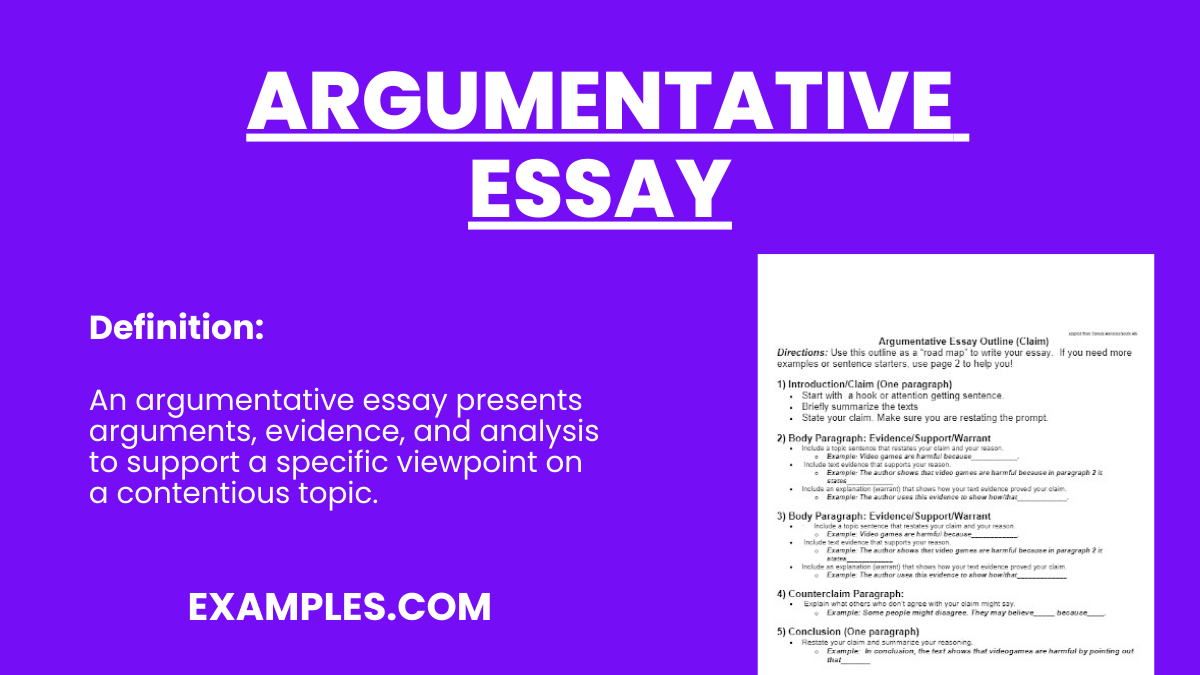
It may be a little bit confusing writing an argumentative essay especially if it is for academic purposes. You should be loaded with facts or verified information to prove your point. Every argument needs an interesting topic for you to keep going with your entire work.
What is an Argumentative Essay? An argumentative essay is a type of writing that presents a clear argument or position on a specific topic, supported by evidence and reasoning. The goal is to persuade the reader to understand and perhaps agree with the writer’s point of view. This essay typically includes a clear thesis statement, structured arguments, factual evidence, and a rebuttal to opposing viewpoints. The effectiveness of an argumentative essay lies in its ability to logically and coherently argue a point, while addressing and countering potential counterarguments.
Format/Structure of Argumentative Essay
An argumentative essay typically follows a clear and structured format to present and support an argument effectively. Here’s a breakdown of its essential components:
Introduction
Hook : Begin with a compelling statement, question, or fact to grab the reader’s attention. Background Information : Provide context or background necessary to understand the topic or argument. Thesis Statement : Clearly state your main argument or position on the topic. This should be precise, debatable, and convey the essence of your essay.
Body Paragraphs
Paragraph 1 : Start with your strongest point or most convincing argument. Provide evidence (facts, statistics, studies, quotes) to support it. Paragraph 2 and Beyond : Continue with subsequent arguments, each in its own paragraph. Ensure each point logically follows the previous one and adds weight to your overall argument. Counterargument : Address a potential counterargument to your thesis, then refute it with logic, evidence, or both. This shows you’ve considered multiple viewpoints.
Restate Thesis : Reaffirm your thesis statement, but in different words. Summarize Key Points : Briefly recap the main arguments you presented. Call to Action or Final Thought : End with a thought-provoking statement, question, or call to action that encourages further thinking or action on the topic.
The Best Example of Argumentative Essay
Title: The Necessity of Environmental Conservation Introduction The planet’s environmental health is a concern that affects all of humanity. Despite differing opinions, the need for environmental conservation is imperative for the following reasons: the survival of future generations, the balance of ecosystems, and the preservation of natural beauty. Thesis Statement Environmental conservation is not just a moral duty but a necessary action for the survival and prosperity of our planet and future generations. Body Paragraph 1: Survival of Future Generations Firstly, conserving the environment ensures the survival of future generations. Practices such as reducing carbon emissions and protecting natural habitats are crucial. For instance, reducing carbon emissions minimizes the greenhouse effect, directly impacting global warming and climate change. Body Paragraph 2: Balance of Ecosystems Secondly, the conservation of the environment is essential for maintaining the balance of ecosystems. Human activities have led to the extinction of numerous species. Preserving natural habitats helps maintain biodiversity, which is vital for ecological balance, as emphasized in a study by the World Wildlife Fund. Body Paragraph 3: Preservation of Natural Beauty Lastly, environmental conservation is important for preserving the natural beauty of the planet. Natural landscapes like forests, oceans, and mountains not only have aesthetic value but also contribute to human well-being, as suggested by numerous psychological studies. Counterargument and Rebuttal Some argue that economic development should take precedence over environmental conservation. However, sustainable development models show that economic growth does not have to be at the environment’s expense. Green technologies and eco-friendly practices can lead to economic prosperity while preserving the environment. Conclusion In conclusion, environmental conservation is a critical necessity. It ensures the survival of future generations, maintains ecological balance, and preserves the planet’s intrinsic beauty. The path towards sustainable development is not only possible but essential, aligning economic growth with environmental stewardship.
Argumentative Essay Topics with Samples
- The Impact of Social Media on Mental Health
- Should Vaccinations be Mandatory for Public Health?
- The Role of Artificial Intelligence in the Future of Work
- Climate Change: Myth or Reality?
- The Ethics of Genetic Editing in Humans
- Universal Basic Income: Solution to Economic Inequality?
- The Influence of Video Games on Youth Behavior
- Animal Testing: Necessary Evil or Outdated Practice?
- Is Remote Learning Effective in Education?
- The Debate on Gun Control Laws in the United States
- The Pros and Cons of Capital Punishment
- Privacy vs. Security in the Age of Surveillance
- The Cultural Impact of Globalization
- Vegetarianism and Veganism: Dietary Choice or Moral Obligation?
- The Rise of Cryptocurrencies: Future of Finance or Speculative Bubble?
Types of Argumentative Essay and How to Use Them?
Argumentative essays can be categorized into different types based on the approach and purpose of the argument. Understanding these types helps in crafting a more effective and targeted essay:
Classical (Aristotelian) Argumentative Essay
Rooted in the principles of Aristotle, this type of essay presents a clear, direct argument. It starts with an introduction of the topic, followed by the presentation of the writer’s position. The body provides logical reasoning and evidence supporting the argument, and it addresses and refutes counterarguments. The conclusion reinforces the thesis and sums up the argument.
Use this style for topics that can be argued logically and objectively. It’s effective in academic writing and debates where clear, rational arguments are needed.
Rogerian Argumentative Essay
This approach, based on the psychology of Carl Rogers, emphasizes understanding and finding common ground with the opposing viewpoint. Instead of outright refuting the opposing views, the writer acknowledges their validity and seeks a compromise or integrative solution.
Ideal for contentious or polarizing topics where bridging opposing views is important. It’s useful in emotionally charged debates where acknowledging different perspectives can lead to a more balanced conclusion.
Toulmin Argumentative Essay
Developed by Stephen Toulmin, this model focuses on constructing a clear and logical argument. It consists of six elements: claim, grounds (evidence), warrant (link between the claim and evidence), backing (support for the warrant), qualifier (limits of the claim), and rebuttal (addressing counterarguments).
Employ this method for complex arguments that require detailed analysis. It’s suitable for scientific or technical discussions where each aspect of the argument must be logically validated.
Persuasive Argumentative Essay
This type aims to persuade the audience to the writer’s point of view through emotional appeal and moral reasoning. It uses strong, emotive language and persuasive techniques like anecdotes, rhetorical questions, and sometimes, dramatic illustrations to sway the reader’s opinion.
Best for topics related to personal beliefs, values, or when the goal is to influence public opinion. Effective in speeches, advertising, and situations where emotional impact is crucial.
9+ Argumentative Essay Outline Examples
1. argumentative pattern essay outline.
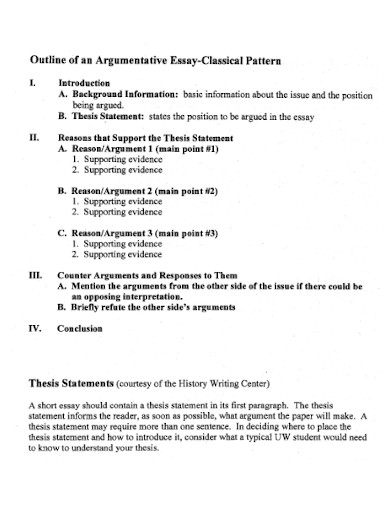
depts.washington.edu
Size: 28 KB
2. Argumentative Classical Model Essay Outline
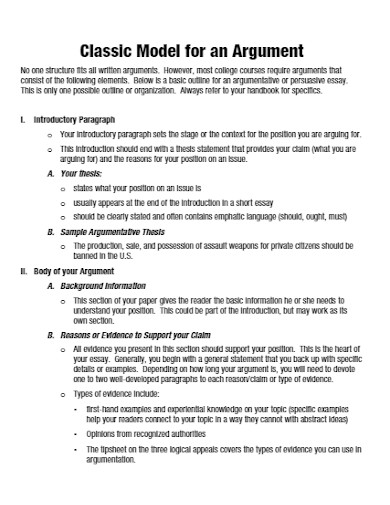
valenciacollege.edu
Size: 52 KB
3. Argumentative Essay Writing Outline
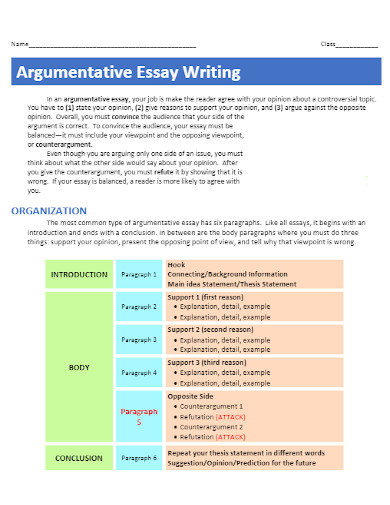
matthewbarbee.com
Size: 857 KB
4. Argumentative Essay Planning Outline
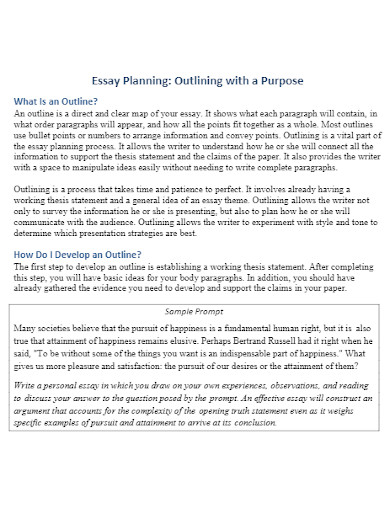
Size: 457 KB
5. Argumentative Essay Claim Outline
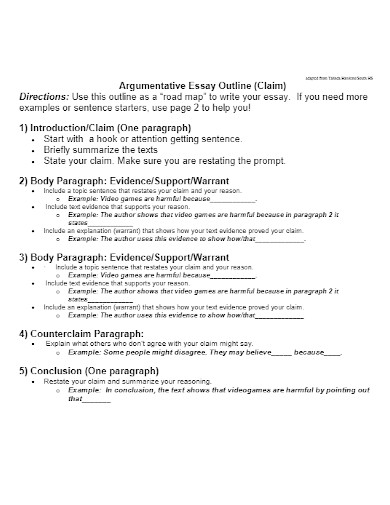
Size: 392 KB
6. Sample Argumentative Essay Outline
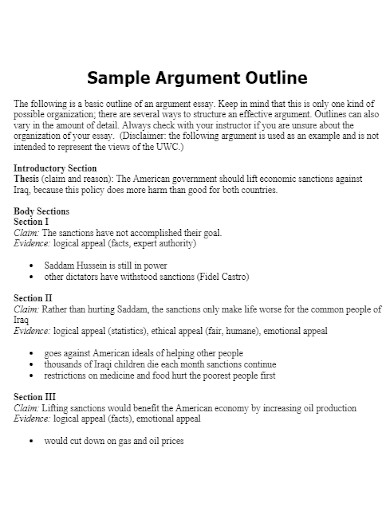
uwc.cah.ucf.edu
Size: 98 KB
7. Argumentative Essay of Debatable Outline
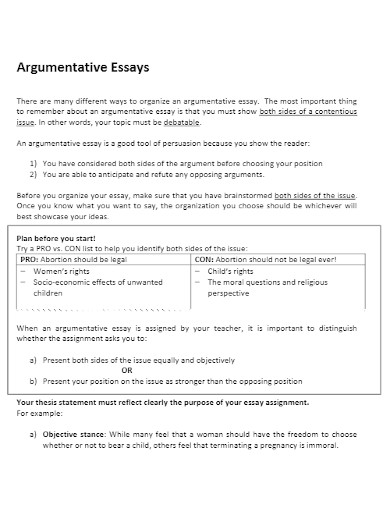
georgebrown.ca
Size: 348 KB
8. Argumentative Essay of Persuasive Outline
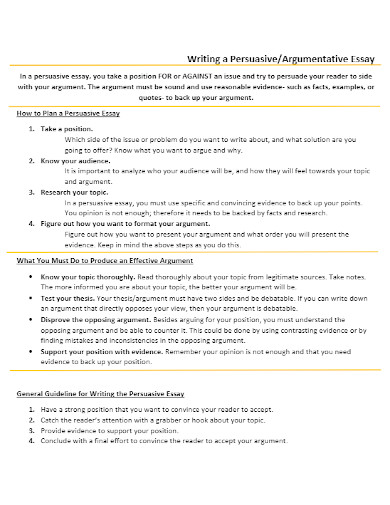
Size: 311 KB
9. Editable Argumentative Essay Outline
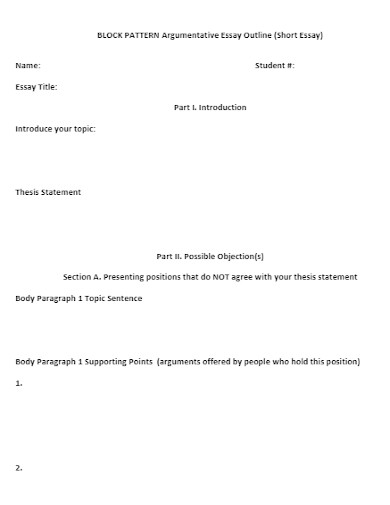
alexandercollege.ca
Size: 178 KB
10. Printable Argumentative Essay Outline

Size: 138 KB
Elements of an Argumentative Essay
Introduction .
this is the first part of your paper where you are going to talk about a certain issue in a way that you can grab the attention of your audience.
In your introduction, you should provide an opening line that will keep your readers stuck into your work until the end.
this is the summary of your main idea supported by evidences
This is located at the end of your first paragraph. Every point you take in your argumentative essay must be related to the thesis statement that you wrote.
these were also referred to as “claims”. This is all about the data and facts that you use to prove your point.
Justification
this justifies or explains your evidence. In your argumentative essay, you have to provide at least three paragraphs of supporting details that backs up your evidence.
Opposing argument
this is also called “refutation” that proves your opinion may not be true. Unlike any other essays like in a persuasive essay, an argumentative essay will let you see through the other side of the matter. Your work will appear stronger since it will be weighing two different stands whether which argument is more believable.
Conclusion
this is the summary of your entire argument including your main idea and the evidence. Always take note that you have to provide a concise conclusion.
You may want to check an example of a good argumentative essay below.
“The first objection last week came from the National Organization for Women and the New York Civil Liberties Union, both of which opposed the opening of TYWLS in the fall of 1996. The two groups continue to insist – as though it were 1896 and they were arguing Plessy V. Ferguson – that separate can never be equal. I appreciate NOW’s wariness of the Bush administration’s endorsement of single-sex public schools, since I am of the generation that still considers the label “feminist” to be a compliment – and many feminist still fear that any public acknowledgement of differences between the sexes will hinder their fight for equality.” – Boys Here, Girls There: Sure, If Equality’s the Goal (by Karen Stabiner) “We’ve become accustomed to a new way of being “alone together.” Technology-enabled, we are able to be with one another, and also elsewhere, connected to wherever we want to be. We want to customize our lives. We want to move in and out of where we are because the thing we value most is control over where we focus our attention. We have gotten used to the idea of being in a tribe of one, loyal to our own party.” – The Flight from Conversation (by Sherry Turkle)
What makes a good argumentative essay?
A good argumentative essay has focuses on facts rather than opinions and clear evidence that supports your claim.
How long is an argumentative essay?
It depends on how long your introduction, supporting facts and conclusion is.
Do I still need to provide a reference in my argumentative essay?
Every type of writing must have a reference page.
Argumentative essays must be supplied with strong arguments to convince the readers more about a debatable issue. It should contain elements such as introduction, thesis, evidence, justification, opposing argument and conclusion.
Text prompt
- Instructive
- Professional
Write an argumentative essay on whether school uniforms should be mandatory.
Discuss in an argumentative essay if animals should be kept in zoos.

IMAGES
VIDEO
COMMENTS
An essay outline is a way of planning the structure of your essay before you start writing. It involves writing quick summary sentences or phrases for every point you will cover in each paragraph, giving you a picture of how your argument will unfold. You'll sometimes be asked to submit an essay outline as a separate assignment before you ...
How to Write an Essay Outline in 4 Steps. Creating an essay outline is a crucial step in crafting a well-structured and organized piece of writing. Follow these four simple steps to create an effective outline: Step 1: Understand the Topic. To begin, thoroughly grasp the essence of your essay topic.
How to Outline an Essay: Basic Essay Outline Template. Written by MasterClass. Last updated: Jun 7, 2021 • 3 min read. Essay outlines are excellent tools for organizing your writing. A strong outline can turn a meandering essay into a focused, persuasive piece of writing.
Making a detailed outline before you begin writing is a good way to make sure your ideas come across in a clear and logical order. A good outline will also save you time in the revision process, reducing the possibility that your ideas will need to be rearranged once you've written them. The First Steps. Before you can begin outlining, you need ...
An essay outline is a way of planning the structure of your essay before you start writing. In just 3 minutes, this video will show you how to organize your ...
Outlining is a tool we use in the writing process to help organize our ideas, visualize our paper's potential structure, and to further flesh out and develop points. It allows the writer to understand how he or she will connect information to support the thesis statement and the claims of the paper. An outline provides the writer with a space ...
3. Expository essay outline. An expository essay outline requires you to provide a detailed overview of a subject from all angles. It is used to test your knowledge of a particular subject. The purpose of this essay outline is to inform, explain, or describe a topic or idea, rather than to persuade the reader or share personal opinions.
Why it's worth writing an outline. How to outline a paper. Step 1: gather your relevant materials. Step 2: create your thesis. Step 3: find examples. Step 4: analyze your examples. Step 5: arrange your examples. An example.
The best outlines are clear and organized, and help you build a strong essay. Here's what goes into this winning formula: Clear and Concise: Your outline is like a map, not a story. Use short words or key ideas to show what each part is about. Keep it short and sweet - you can add details later in your essay.
You will typically have three for an essay outline: one for your introduction, one for your body, and one for your conclusion. Capitalized letters (A,B,C, etc.) mark each primary point within a major section. Arabic numerals (1, 2, 3, etc.) are used to flesh out primary points.
Our essay writer recommends you to follow these simple steps: 1. Develop a Topic. The first step in your outline is to identify your topic. Once you have a clear understanding of the instructor's expectations, begin brainstorming topics that fit within the assignment.
Directly below, write your thesis statement, setting it apart by capitalizing the first letter of each word and ending with a colon. This establishes the overarching argument or main point of your essay. Headings and Subheadings: Use a hierarchical system for headings and subheadings to denote the structure of your MLA essay.
The outline headings are your main points. You'll label these headings with Roman Numerals for an alphanumeric outline (I, II, III) or with Arabic Numerals for a decimal outline (1.0, 2.0, 3.0). If you're writing an essay, this would be the body of your essay. These ideas should be drawn directly from your thesis or controlling idea.
Outlining is a vital part of the essay planning process. It allows the writer to understand how he or she will connect all the information to support the thesis statement and the claims of the paper. It also provides the writer with a space to manipulate ideas easily without needing to write complete paragraphs.
Compare and contrast essays examine the similarities and differences between two subjects, offering a balanced view. For example, a compare and contrast essay on "Online Learning vs. Traditional Classroom" might follow this outline: I. Introduction. A. Discuss the rise of online learning platforms.
Brainstorm: List all the ideas that you want to include in your paper. Organize: Group related ideas together. Order: Arrange material in subsections from general to specific or from abstract to concrete. Label: Create main and sub headings. Remember: creating an outline before writing your paper will make organizing your thoughts a lot easier.
The same applies to essay writing. Once you've brainstormed and gathered your ideas, you know what you want to communicate, but it's crucial to organize how you will express it. Construct an outline that organizes the essay into distinct sections. Structuring Your Story. Organize your essay to include an introduction, body, and conclusion.
An argumentative essay is a type of writing that presents a clear argument or position on a specific topic, supported by evidence and reasoning. The goal is to persuade the reader to understand and perhaps agree with the writer's point of view. ... 9+ Argumentative Essay Outline Examples 1. Argumentative Pattern Essay Outline. depts ...